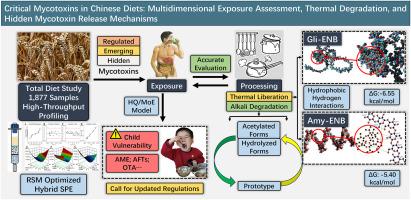中国人饮食中的关键真菌毒素:多维暴露评估、热降解和隐藏的真菌毒素释放机制
IF 6.6
1区 农林科学
Q1 FOOD SCIENCE & TECHNOLOGY
引用次数: 0
摘要
真菌毒素构成重大的全球食品安全风险,新出现的和隐藏的形式需要紧急关注。本研究采用优化的UHPLC-MS/MS和C18/ emr -脂质混合清理技术,对15个食品类别的46种真菌毒素进行了总体饮食研究。结果显示,73.7%的样品含有两种或两种以上的真菌毒素。联苯醚单甲醚(危险系数为313% - 346%)、黄曲霉毒素B1、赭曲霉毒素A和sterigmatocystin(暴露范围:65.4-172 < 10,000)被确定为高风险污染物。值得注意的是,2-7岁儿童的暴露风险特别高,其脆弱性比成人高120% - 250%。在热/酶处理过程中检测到显著水平的隐性enniatins并释放出来;消化增加了超过200%的enniatin B/B1水平,显示出大量的基质结合储备。分子对接模拟进一步阐明了潜在的结合机制,证实了enniatins与直链淀粉和麦胶蛋白之间的相互作用主要是通过非共价键介导的,特别是通过广泛的氢键网络和主要的疏水相互作用(ΔG: 5.40至−6.55 kcal/mol)。热处理(>150°C)和碱性条件(pH > 12)可以促进隐藏到自由的转化。这些发现强调了在暴露评估和更新法规中考虑隐藏真菌毒素的必要性,特别是针对弱势群体和高风险商品。本文章由计算机程序翻译,如有差异,请以英文原文为准。

Critical mycotoxins in Chinese diets: Multidimensional exposure assessment, thermal degradation, and hidden mycotoxin release mechanisms
Mycotoxins pose significant global food safety risks, with emerging and hidden forms requiring urgent attention. This study conducted a total diet study covering 15 food categories to assess the contamination of 46 mycotoxins using optimized UHPLC-MS/MS with C18/EMR-Lipid hybrid cleanup. The results revealed that 73.7 % of the samples contained two or more mycotoxins. Alternariol monomethyl ether (hazard quotient 313 %–346 %), aflatoxin B1, ochratoxin A, and sterigmatocystin (margin of exposure: 65.4–172 < 10,000) were identified as high-risk contaminants. Notably, 2–7 years children exhibited particularly elevated exposure risks, with vulnerability 120 %–250 % higher than that of adults. Significant levels of hidden enniatins were detected and released during thermal/enzymatic processing; digestion increased enniatin B/B1 levels by over 200 %, revealing substantial matrix-bound reserves. Molecular docking simulations further elucidated the underlying binding mechanisms, confirming that the interactions between enniatins and both amylose and gliadin are primarily mediated by non-covalent bonding, specifically through an extensive hydrogen-bonding network and dominant hydrophobic interactions (ΔG: 5.40 to −6.55 kcal/mol). Thermal treatment (>150 °C) and alkaline conditions (pH > 12) could facilitate the hidden-to-free conversion. These findings underscore the necessity of accounting for hidden mycotoxins in exposure assessments and updating regulations, especially for vulnerable populations and high-risk commodities.
求助全文
通过发布文献求助,成功后即可免费获取论文全文。
去求助
来源期刊

LWT - Food Science and Technology
工程技术-食品科技
CiteScore
11.80
自引率
6.70%
发文量
1724
审稿时长
65 days
期刊介绍:
LWT - Food Science and Technology is an international journal that publishes innovative papers in the fields of food chemistry, biochemistry, microbiology, technology and nutrition. The work described should be innovative either in the approach or in the methods used. The significance of the results either for the science community or for the food industry must also be specified. Contributions written in English are welcomed in the form of review articles, short reviews, research papers, and research notes. Papers featuring animal trials and cell cultures are outside the scope of the journal and will not be considered for publication.
 求助内容:
求助内容: 应助结果提醒方式:
应助结果提醒方式:


